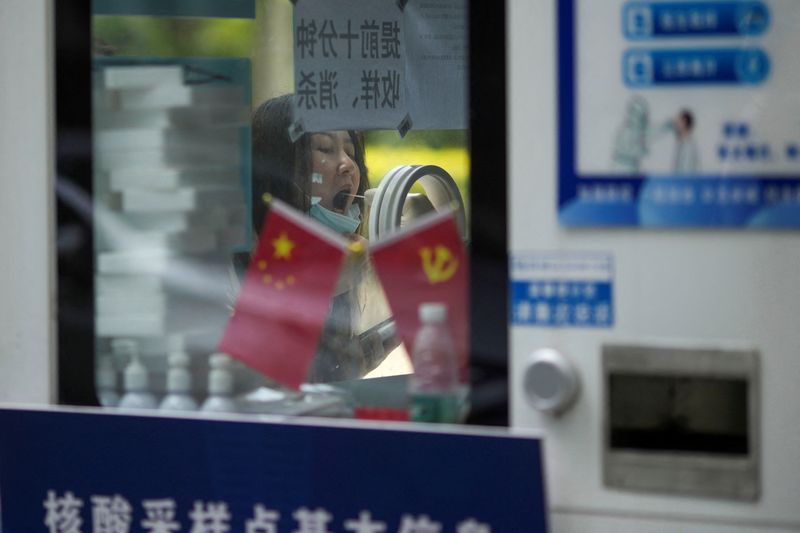Analysis-As China party congress looms, signals sought on easing COVID policy
2022.10.06 19:21
[ad_1]

© Reuters. FILE PHOTO: A woman gets tested for the coronavirus disease (COVID-19) at a nucleic acid testing site, following the coronavirus disease outbreak, in Shanghai, China, September 23, 2022. REUTERS/Aly Song
By Tony Munroe and Miyoung Kim
BEIJING (Reuters) – The mounting economic toll of China’s zero-COVID policy is raising investor hopes that Beijing may finally begin laying the groundwork for the tricky epidemiological and political task of shifting course following this month’s Communist Party congress.
It is not clear whether the ruling party congress from Oct. 16 will shed any light on easing strict measures to extinguish all domestic COVID-19 outbreaks, rather than seek to live with the pandemic. Any change, economists and investors predict, would entail gradual steps for a reopening from the first half of 2023 at the earliest.
Tackling the challenges of reversing one of the world’s toughest COVID regimes would require a clear timeline and strategy for booster shots in a nation of 1.4 billion people that has gone its own way on inoculations, say infectious-disease and vaccine experts.
The approach has all but shut its borders for travel and led to unpredictable lockdowns of huge cities, stifling the world’s second-largest economy and stoking anger and frustration among many citizens.
Xi Jinping, expected to secure a precedent-breaking third leadership term at the congress held every five years, reiterated that the zero-COVID policy is “correct and effective” during a June visit to Wuhan, the central Chinese city where COVID emerged in 2019.
“In every conversation that we have had on Asia’s macro outlook, the number one question that investors have is on when China will reopen and what the roadmap would look like,” Morgan Stanley (NYSE:) economists wrote in a research note last week.
“We think a reopening will happen, because the strict COVID management approach has led to challenges of significantly weaker income growth and a sharp rise in youth unemployment – outcomes which are at odds with the policy goal of common prosperity.”
Goldman Sachs (NYSE:) analysts predict China will start relaxing the policy in the April-June quarter.
China has repeatedly tweaked implementation of zero-COVID but not described an exit from a policy that seeks to contain every outbreak, which state media touts as showing the superiority of Chinese governance to that in the West.
LOCAL SHOTS
Zero-COVID, while disruptive, has kept death and infection rates minimal, which could reassure the public that preparation for a gradual reopening would allow China to balance economic concerns and COVID risks.
But China’s population, the world’s largest, has little natural immunity given the rigorous containment policy.
Before exposing China’s people to new COVID risk, authorities must prepare a healthcare system with wide inequality in the geographical distribution of resources for a surge in infections and adjust its messaging to people accustomed to the extremes of zero-COVID.
China boasts nine domestically developed COVID vaccines approved for use, more than any other country. But none has been updated to target the highly infections Omicron variant, as Pfizer-BioNTech and Moderna (NASDAQ:) have for boosters in many developed countries.
The authorities have not approved any foreign-made COVID shots. A recent study showed the most widely used shots in China were effective in preventing severe cases and deaths but showed lower effectiveness against the Omicron variant.
Home-grown mRNA vaccines in development have not been green-lighted domestically, but Indonesia said last week it had approved emergency use of an mRNA vaccine developed by China’s Walvax Biotechnology Co Ltd.
Executives at three Chinese vaccine makers told Reuters a key uncertainty is whether regulators will allow fast-track opportunities for new vaccines as China did in 2020 by authorising emergency use before efficacy data from large clinical trials was generated.
Without fast-tracking, candidates that started clinical trials this year would lack the data to seek approval by year’s end, said one executive, who, like others, asked not to be named given the sensitivity of the issue.
TIMING MATTERS
For late-comers whose vaccines face the unpredictability of future virus mutation while navigating a lengthy regulatory pathway, “chances are high that you will never keep up with variants or regulatory process,” said another executive.
Two executives expressed scepticism whether regulators would let new candidates skip early-stage trials in unvaccinated people, a group increasingly difficult to gather, even though such shots are more likely to be used as a booster.
The National Health Commission and the National Medical Products Administration did not respond to Reuters requests for comment.
The timing of any booster roll-out is also crucial.
“If you boost everyone now but you don’t have to exit for many months, that’s possibly too early. You want to have the booster at the right time,” said Benjamin Cowling, an epidemiologist at the University of Hong Kong.
“What I haven’t seen in the mainland is that overall plan and the overall timeline.”
Many countries offer second booster shots. China’s CDC said in September a well-timed second booster is needed to safely exit the pandemic. The government allows only one booster.
Some experts recommend importing Western-made shots and accelerating development of home-grown alternatives including Omicron-targeting shots.
“China should … import or develop a highly effective vaccine as soon as possible,” said Zuofeng Zhang, an epidemiology professor at the University of California, Los Angeles.
Cowling said Western-made shots and China-developed candidates showing promising data would also provide more options and help alleviate vaccine hesitancy, a major reason vaccination rates for the elderly remain below China’s national average.
[ad_2]
Source link








